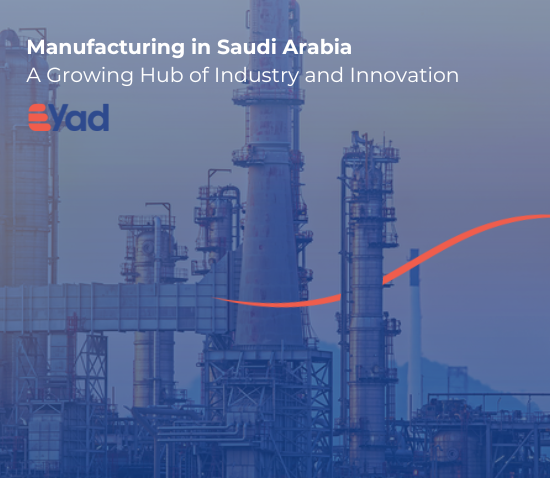Manufacturing in Saudi Arabia: A Growing Hub of Industry and Innovation

Saudi Arabia is quickly emerging as a global leader in manufacturing, leveraging its strategic location, vast natural resources, and ambitious government policies. Over the past decade, the Kingdom has made significant strides in diversifying its economy and establishing itself as a manufacturing powerhouse. With initiatives such as Vision 2030, the country aims to reduce its dependence on oil and expand sectors like technology, automotive, and pharmaceuticals.
Saudi Arabia offers attractive investment incentives, particularly in the form of tax benefits and zakat exemptions, to encourage both local and foreign investors in the manufacturing sector. These measures not only lower operational costs but also foster a competitive business environment, making Saudi Arabia a prime destination for industrial growth and expansion.
This article delves into the current state, opportunities, and future of manufacturing in Saudi Arabia.
The State of Manufacturing in Saudi Arabia
Saudi Arabia’s manufacturing sector has witnessed remarkable growth, with the country actively investing in industrial zones, advanced technologies, and workforce development. As of 2022, the manufacturing sector contributes approximately 10% to the country’s GDP, and this figure is expected to rise significantly in the coming years.
Key Industries in Saudi Manufacturing
- Petrochemicals and Chemicals Saudi Arabia is home to some of the world’s largest petrochemical companies, including SABIC (Saudi Basic Industries Corporation). With access to abundant raw materials, the petrochemical industry remains a cornerstone of the Kingdom’s manufacturing sector.
- Automotive Industry The government’s efforts to develop an automotive manufacturing hub are bearing fruit. Companies like Lucid Motors, supported by the Public Investment Fund (PIF), are setting up electric vehicle (EV) production plants in Saudi Arabia, aiming to produce 155,000 vehicles annually by 2026.
- Pharmaceuticals The pharmaceutical industry is rapidly growing, with domestic companies producing vaccines, generic drugs, and biosimilars. Saudi Arabia’s National Industrial Development and Logistics Program (NIDLP) actively supports this sector, targeting both local and global markets.
- Renewable Energy Equipment In alignment with Vision 2030, the Kingdom is heavily investing in renewable energy projects, including manufacturing solar panels and wind turbines. NEOM’s ambitious plans further emphasize this commitment.
Supporting Infrastructure and Policies
Saudi Arabia has established over 40 industrial cities managed by MODON (Saudi Industrial Property Authority). These cities offer advanced infrastructure, logistical support, and incentives for businesses, such as tax exemptions and streamlined regulatory processes. Additionally, the Saudi Export Development Authority (SEDA) helps local manufacturers access global markets.
Opportunities in Saudi Manufacturing
Strategic Location
Saudi Arabia’s geographical position serves as a gateway between Asia, Europe, and Africa, making it an ideal hub for global trade. This location advantage allows manufacturers to easily access over 2 billion potential consumers across three continents.
Investment Incentives
The Saudi government provides extensive incentives to attract foreign and domestic investors. These include 100% foreign ownership, reduced energy costs, and funding support through programs like the Saudi Industrial Development Fund (SIDF).
Advanced Technologies
The adoption of Industry 4.0 technologies, such as artificial intelligence (AI), robotics, and the Internet of Things (IoT), is transforming Saudi Arabia’s manufacturing landscape. These advancements enhance productivity, reduce costs, and promote sustainability.
Skilled Workforce Development
Saudi Arabia is heavily investing in education and vocational training to prepare its workforce for advanced manufacturing roles. Institutions like the Technical and Vocational Training Corporation (TVTC) and partnerships with global universities play a crucial role in this initiative.
Challenges Facing Manufacturing in Saudi Arabia
While the outlook is promising, the manufacturing sector faces challenges such as:
- Dependence on Imported Machinery Despite efforts to localize production, Saudi manufacturers still rely heavily on imported equipment, which increases operational costs.
- Regulatory Barriers Although reforms are underway, navigating bureaucratic processes can be time-consuming for new businesses.
- Competition Saudi manufacturers must compete with well-established global players, particularly in high-tech industries.
The Future of Manufacturing in Saudi Arabia
The future of Saudi Arabia’s manufacturing sector looks bright, supported by transformative projects and government initiatives. For instance, the $500 billion NEOM project includes industrial hubs like Oxagon, designed to revolutionize manufacturing with cutting-edge technologies and sustainable practices.
Moreover, the Kingdom’s focus on renewable energy and electric vehicles aligns with global trends, positioning Saudi Arabia as a key player in the global manufacturing landscape.
Statistics Highlighting Growth
- The manufacturing sector’s contribution to Saudi Arabia’s GDP grew by 7.5% annually between 2016 and 2021.
- Foreign direct investment (FDI) in manufacturing reached $12 billion in 2022, reflecting strong investor confidence.
An Analogy to Consider
Think of Saudi Arabia’s manufacturing industry as a seed planted in fertile soil. With Vision 2030 as the sunlight and government incentives as the water, this seed is growing into a robust tree, offering fruits of economic diversification and global recognition.
FAQs About Manufacturing in Saudi Arabia
1. What is Vision 2030, and how does it impact manufacturing in Saudi Arabia?
Vision 2030 is Saudi Arabia’s strategic framework to diversify its economy and reduce its reliance on oil. It directly supports manufacturing through investments, infrastructure development, and initiatives like the National Industrial Development and Logistics Program (NIDLP).
2. What industries are thriving in Saudi Arabia’s manufacturing sector?
Key industries include petrochemicals, automotive, pharmaceuticals, and renewable energy equipment manufacturing.
3. Are there incentives for foreign manufacturers to invest in Saudi Arabia?
Yes, the government offers several incentives, including 100% foreign ownership, tax exemptions, and access to funding through programs like the Saudi Industrial Development Fund (SIDF).
4. How is Saudi Arabia addressing the challenge of workforce development?
Saudi Arabia invests heavily in education and vocational training programs, such as those offered by the Technical and Vocational Training Corporation (TVTC), to prepare its workforce for advanced manufacturing roles.
5. What role does technology play in Saudi manufacturing?
Advanced technologies like AI, robotics, and IoT are transforming the sector by increasing efficiency, reducing costs, and promoting sustainability.
